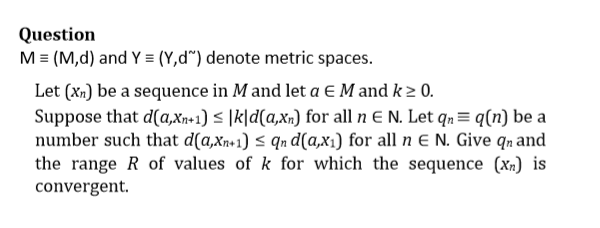Question M = (M,d) and Y = (Y,d") denote metric spaces. Let (xn) be a sequence in M and let a E M and k ≥ 0. Suppose that d(a,xn+1) ≤ |k|d(a,xn) for all n E N. Let qn = q (n) be a number such that d(a,xn+1) ≤ qn d(a,x₁) for all n E N. Give qn and the range R of values of k for which the sequence (xn) is convergent.
Question M = (M,d) and Y = (Y,d") denote metric spaces. Let (xn) be a sequence in M and let a E M and k ≥ 0. Suppose that d(a,xn+1) ≤ |k|d(a,xn) for all n E N. Let qn = q (n) be a number such that d(a,xn+1) ≤ qn d(a,x₁) for all n E N. Give qn and the range R of values of k for which the sequence (xn) is convergent.
Algebra & Trigonometry with Analytic Geometry
13th Edition
ISBN:9781133382119
Author:Swokowski
Publisher:Swokowski
Chapter10: Sequences, Series, And Probability
Section10.1: Infinite Sequences And Summation Notation
Problem 72E
Related questions
Question
Help please with

Transcribed Image Text:Question
M = (M,d) and Y = (Y,d") denote metric spaces.
Let (xn) be a sequence in M and let a E M and k ≥ 0.
Suppose that d(a,xn+1) ≤ |k|d(a,xn) for all n E N. Let qn = q (n) be a
number such that d(a,xn+1) ≤ qn d(a,x₁) for all n E N. Give qn and
the range R of values of k for which the sequence (xn) is
convergent.
Expert Solution
This question has been solved!
Explore an expertly crafted, step-by-step solution for a thorough understanding of key concepts.
Step by step
Solved in 5 steps with 6 images

Recommended textbooks for you

Algebra & Trigonometry with Analytic Geometry
Algebra
ISBN:
9781133382119
Author:
Swokowski
Publisher:
Cengage

Elementary Linear Algebra (MindTap Course List)
Algebra
ISBN:
9781305658004
Author:
Ron Larson
Publisher:
Cengage Learning

Algebra & Trigonometry with Analytic Geometry
Algebra
ISBN:
9781133382119
Author:
Swokowski
Publisher:
Cengage

Elementary Linear Algebra (MindTap Course List)
Algebra
ISBN:
9781305658004
Author:
Ron Larson
Publisher:
Cengage Learning